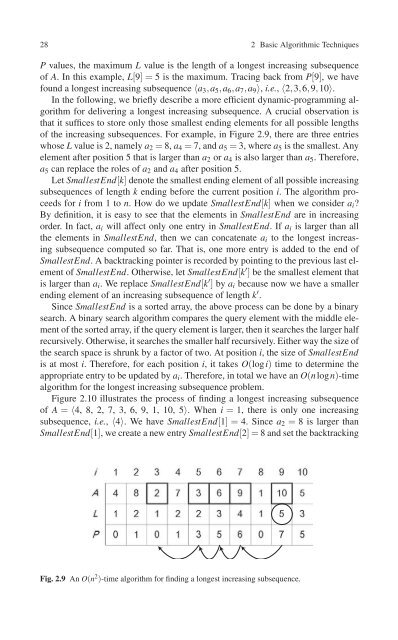Create successful ePaper yourself
Turn your PDF publications into a flip-book with our unique Google optimized e-Paper software.
28 2 Basic Algorithmic Techniques<br />
P values, the maximum L value is the length of a longest increasing subsequence<br />
of A. In this example, L[9] =5 is the maximum. Tracing back from P[9], wehave<br />
found a longest increasing subsequence 〈a 3 ,a 5 ,a 6 ,a 7 ,a 9 〉, i.e., 〈2,3,6,9,10〉.<br />
In the following, we briefly describe a more efficient dynamic-programming algorithm<br />
for delivering a longest increasing subsequence. A crucial observation is<br />
that it suffices to store only those smallest ending elements for all possible lengths<br />
of the increasing subsequences. For example, in Figure 2.9, there are three entries<br />
whose L value is 2, namely a 2 = 8, a 4 = 7, and a 5 = 3, where a 5 is the smallest. Any<br />
element after position 5 that is larger than a 2 or a 4 is also larger than a 5 . Therefore,<br />
a 5 can replace the roles of a 2 and a 4 after position 5.<br />
Let SmallestEnd[k] denote the smallest ending element of all possible increasing<br />
subsequences of length k ending before the current position i. The algorithm proceeds<br />
for i from 1 to n. How do we update SmallestEnd[k] when we consider a i ?<br />
By definition, it is easy to see that the elements in SmallestEnd are in increasing<br />
order. In fact, a i will affect only one entry in SmallestEnd. Ifa i is larger than all<br />
the elements in SmallestEnd, then we can concatenate a i to the longest increasing<br />
subsequence computed so far. That is, one more entry is added to the end of<br />
SmallestEnd. A backtracking pointer is recorded by pointing to the previous last element<br />
of SmallestEnd. Otherwise, let SmallestEnd[k ′ ] be the smallest element that<br />
is larger than a i . We replace SmallestEnd[k ′ ] by a i because now we have a smaller<br />
ending element of an increasing subsequence of length k ′ .<br />
Since SmallestEnd is a sorted array, the above process can be done by a binary<br />
search. A binary search algorithm compares the query element with the middle element<br />
of the sorted array, if the query element is larger, then it searches the larger half<br />
recursively. Otherwise, it searches the smaller half recursively. Either way the size of<br />
the search space is shrunk by a factor of two. At position i, the size of SmallestEnd<br />
is at most i. Therefore, for each position i, ittakesO(logi) time to determine the<br />
appropriate entry to be updated by a i . Therefore, in total we have an O(nlogn)-time<br />
algorithm for the longest increasing subsequence problem.<br />
Figure 2.10 illustrates the process of finding a longest increasing subsequence<br />
of A = 〈4, 8, 2, 7, 3, 6, 9, 1, 10, 5〉. When i = 1, there is only one increasing<br />
subsequence, i.e., 〈4〉. WehaveSmallestEnd[1] =4. Since a 2 = 8 is larger than<br />
SmallestEnd[1], we create a new entry SmallestEnd[2]=8 and set the backtracking<br />
Fig. 2.9 An O(n 2 )-time algorithm for finding a longest increasing subsequence.

















